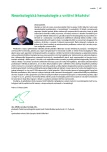Diagnostic strategies in disorders of hemostasis
Authors:
Ingrid Hrachovinová
Authors‘ workplace:
Ústav hematologie a krevní transfuze, Praha
Published in:
Vnitř Lék 2018; 64(5): 537-544
Category:
Overview
Hemostasis is a complicated biological system, where the balance between procoagulation and anticoagulation processes maintains fluidity of blood through intact blood vessels and creates thrombi when it is needed to prevent bleeding from the impaired vessels. The modern model of hemostasis is divided into 2 principal phases, the first being defined as primary hemostasis which involves the platelet-vessel interplay, while the second, defined as secondary hemostasis, mainly involves coagulation factors and surfaces of activated cells. The activation and amplification of the coagulation cascade is regulated by natural inhibitors of coagulation. The blood clots which arise to prevent loss of blood must subsequently be broken down and the compact blood vessel wall must be restored. This process is called fibrinolysis. Bleeding and thromboses are manifestations of the impaired hemostatic balance. Detection of its cause is important for efficient treatment and prevention of the condition. This requires a combined evaluation of the family and personal history, a clinical anamnesis along with the evaluation of laboratory results. It is not reasonable or economical to perform all the available tests of hemostasis at the same time. It is recommendable to proceed from the global to the screening and then special tests and, through the process of elimination, obtain an explanation of the bleeding or prothrombotic phenotypes. The purpose of this report is to provide a brief overview of the principal causes of the hemostatic disorders and the practices which facilitate their diagnosis.
Key words:
diagnosis of hemorrhagic manifestations – diagnostics of thrombophilias – DIC diagnostics – hemophilia A – thrombopathy – von Willebrand disease
Sources
- Kitchens KS, Konkle BA, Kessler CM. Consultative Haemostais and Thrombosis. 2nd ed. Saunders: 2007: Chapter 1: 3–15. ISBN 978–1416024019.
- Key N, Makris M, Lillicrap D (eds). Practical haemostasis and thrombosis. 3rd ed. Wiley-Blackwell: 2017: Chapter 2: 7–16. ISBN 978–1118344712.
- Colman RW, Marder VJ, Clowes AW (eds) et al. Haemostasis and Thrombosis: Basic Principles and Clinical Practice. 5th ed. LWW: 2005: Chapter 27: 1147–1158. ISBN 978–0781749961.
- Sadler JE,Budde U, Eikenboom JC et al. Update on the pathophysiology and classification of von Willebrand disease: a report of the Subcommittee on von Willebrand Factor. J Thromb Haemost 2006; 4(10): 2103–2114. Dostupné z DOI: <http://dx.doi.org/10.1111/j.1538–7836.2006.02146.x>.
- Ng C, Motto DG, Di Paola J. Diagnostic approach to von Willebrand disease. Blood 2015; 125(13): 2029–2037. Dostupné z DOI: <http://dx.doi.org/10.1182/blood-2014–08–528398>.
- Tosetto A, Castaman G, Plug I et al. Prospective evaluation of the clinical utility of quantitative bleeding severity assessment in patients referred for hemostatic evaluation. J Thromb Haemost 2011; 9(6): 1143–1148. Dostupné z DOI: <http://dx.doi.org/10.1111/j.1538–7836.2011.04265.x>.
- Favaloro JE, Bonar RA, Meiring M et al. Evaluating errors in the laboratory identification of von Willebrand disease in the real world. Thromb Res 2014; 134(2): 393–403. Dostupné z DOI: <http://dx.doi.org/10.1016/j.thromres.2014.05.020>.
- Peyvandi F, Palla R, Menegatti M et al. Coagulation factor activity and clinical bleeding severity in rare bleeding disorders: results from the European Network of Rare Bleeding Disorders. J Thromb Haemost 2012; 10(4): 615–621. Dostupné z DOI: <http://dx.doi.org/10.1111/j.1538–7836.2012.04653.x>.
- Castellone DD, Adcock DM. Factor VIII activity and inhibitor assays in the diagnosis and treatment of hemophilia A. Semin Thromb Hemost 2017; 43(3): 320–330. Dostupné z DOI: <http://dx.doi.org/10.1055/s-0036–1581127>.
- Goodeve AC, Pavlova A, Oldenburg J. Genomics of bleeding disorders. Haemophilia 2014; 20(Suppl 4): S50-S53. Dotupné z DOI: <http://dx.doi.org/10.1111/hae.12424>.
- Montagnana M, Lippi G, Danese E. An overview of thrombophilia and associated laboratory testing. Methods Mol Biol 2017; 1646: 113–135. Dostupné z DOI: <http://dx.doi.org/10.1007/978–1-4939–7196–1_9>.
- Thachil J, Lippi G, Favaloro EJ. D-Dimer testing: laboratory aspects and current issues. Methods Mol Biol 2017; 1646: 91–104. Dostupné z DOI: <http://dx.doi.org/10.1007/978–1-4939–7196–1_7>.
- Wada H, Matsumoto T, Yamashita Y. Diagnosis and treatment of disseminated intravascular coagulation (DIC) according to four DIC guidelines. J Intensive Care 2014; 2(1): 15. Dostupné z DOI: <http:// dx.doi.org/10.1186/2052–0492–2-15>.
- Moll S. Thrombophilia: clinical-practical aspects. J Thromb Thrombolysis 2015; 39(3): 367–378. Dostupné z DOI: <http://dx.doi.org/10.1007/s11239–015–1197–3>.
- Pengo V, Tripodi A, Reber et al. Update of the guidelines for lupus anticoagulant detection. Subcommittee on Lupus Anticoagulant/Antiphospholipid Antibody of the Scientific and Standardisation Committee of the International Society on Thrombosis and Haemostasis. J Thromb Haemost. 2009; 7(10): 1737–1740. Dostupné z DOI: <http://doi: 10.1111/j.1538–7836.2009.03555.x>.
- Stevens SM, Woller SC, Bauer KA et al. Guidance for the evaluation and treatment of hereditary and acquired thrombophilia. J Thromb Thrombolysis 2016; 41(1): 154–164. Dostupné z DOI: <http://dx.doi.org/10.1007/s11239–015–1316–1>.
Labels
Diabetology Endocrinology Internal medicineArticle was published in
Internal Medicine

2018 Issue 5
Most read in this issue
- Autoimmune hemolytic anemia
- Differential diagnosis of anemia
- Congenital and acquired bleeding disorders
- Hemoglobinopathies
